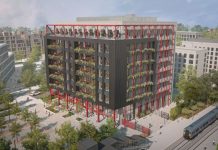Tall buildings in Bristol are shorter than those in other major English cities, according to research by a leading commercial property specialist.
Comparative graphs produced by the Development team in the Bristol office of Colliers International identify the tallest existing and proposed buildings in storeys in Bristol, Birmingham, Leeds, London, Manchester and Newcastle, and also in Scotland and Wales.
The analysis was undertaken in response to the shift in policy on tall buildings in Bristol under the Mayor, Marvin Rees, who has declared that he wanted “Bristol’s skyline to grow”.
Christopher Dawson, head of the Development team, said: “Few in Bristol can be unaware of the Mayor’s willingness to consider taller buildings in the city.
“As a property consultancy with an international and national perspective, Colliers International has responded by undertaking a comparative analysis of building heights in the major cities of the UK. For each of these locations the planning and design framework is considered and the tallest existing and proposed buildings identified.
“From this, it is clear that tall buildings must be assessed in terms of their local context; what may appear tall in one location could be an average height in another location and vice versa.
George Yates from the planning team in the Bristol office of Colliers International found that the planning policies in each city to differ greatly. “Bristol defines tall as nine stories, Leeds as 14 stories and Birmingham as 15 stories. This is hardly surprising although Bristol seems to be at the conservative end of the scale. Given that the city already has a densely developed city core and a varied topography, there should be greater scope for well-designed tall buildings in the right locations.
“Some UK locations, notably Birmingham, Glasgow and Leeds, are particularly supportive of tall buildings in specified areas. The view of the Bristol DCA team at Colliers International is that Bristol has some way to go in this regard.”
Mr Dawson added that the increasing number of tall buildings in cities were a response to pressure to provide accommodation on limited land supply, and the current shift back towards urban living.
“It seems reasonable to predict that the drive for height will continue where it is economically viable,” he said.
“However, that drive will only be part of a broader balance of supply. Not everybody wants apartment living in city centres and for families the traditional two/three storey house is likely to remain at the market core.
“Indeed, the novelty of dense high rise urban living may wear off as it becomes more prevalent: take a trip on the Docklands Light Railway in London to see what I mean. If so, this may prove a natural market check too.
“But, in the medium term and from a Bristol perspective, the view of the Bristol DCA team is that tall and beautiful buildings enhance our cities.”



















